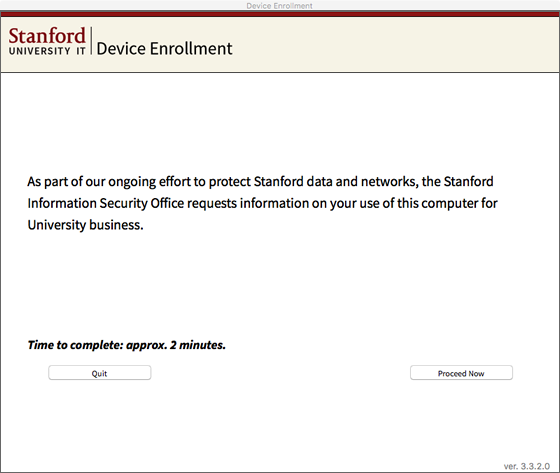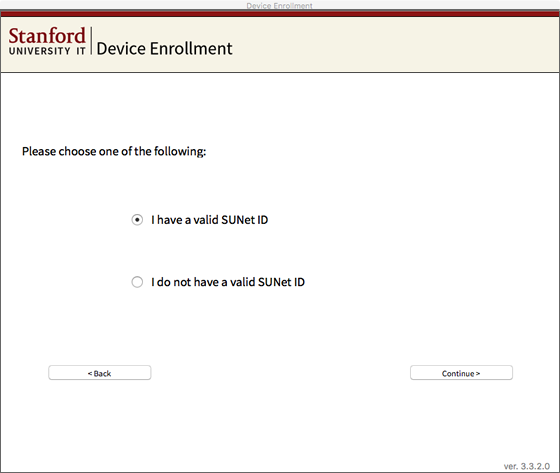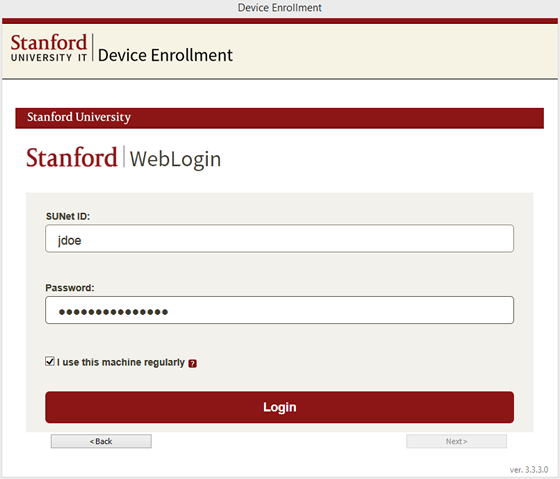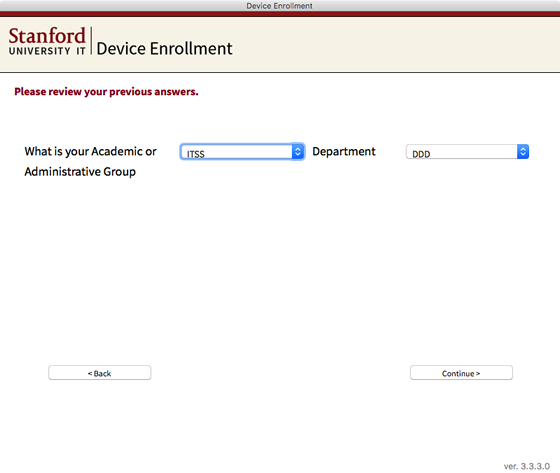The Device Enrollment app presents you with a brief questionnaire. Stanford needs to gather some information about your computer to ensure it meets security standards. Enrollment also associates a computer with the person who is responsible for its data security in MyDevices. Depending on the information you store on your computer, you may need to encrypt your hard drive.
Download software
Enroll
- Run the installer. A setup wizard guides you through the steps necessary to install the software.
- As soon as the software is installed successfully, a questionnaire regarding the use of this computer for Stanford business launches. Click Proceed Now.

- Next, choose whether or not you have a valid SUNet ID and then click Continue.

- If you have a valid SUNet ID:
- Enter your SUNet ID and password on the WebLogin screen.

- You will be asked to answer some questions about this device and the types of data that is accessed and stored on it.
- If BigFix, Stanford's patch management software, is not present on your computer, you are given the option to install it.
- If you choose to install BigFix now, select the group and (if applicable) the sub-group that describes where your computer is located and then click Continue.

- Enter your SUNet ID and password on the WebLogin screen.
- If you do not have a valid SUNet ID:
- If you are no longer affiliated with Stanford, you are asked to remove BigFix. The BigFix uninstaller launches automatically when you exit the questionnaire.
- If this computer is used for Stanford work, the questionnaire is terminated. Someone with a valid SUNet ID needs to complete the questionnaire.
How to answer the questionnaire
Are you the primary user (or the party responsible for the data security) of this computer?
- Yes: You use this machine more than anyone else, make decisions about what applications are on it, or generally consider it your computer.
- No: This machine is in a computer lab or a general use machine.
Do other people use this computer?
- Yes: Other people use this machine by logging in via another user name or use it using the same login as you for more than a few minutes a day.
- No: Others only use this machine occasionally and do not have their own login.
Is this a Stanford owned computer?
- Yes: This machine was paid for by your school, department, program, supervisor, PI, grant, or other Stanford funds. Or, this machine was paid for by you, using your personal funds and reimbursed by Stanford.
- No: This machine was paid for by you, using your personal funds and not reimbursed by Stanford.
Is this computer used for Stanford-related work, including even minimal use of email, voicemail, or Stanford files?
- Yes: You work with any data related to Stanford, not including personal data such as your pay statements, or personal benefits information.
- No: You do not do any work for Stanford on this machine or only have personal data from Stanford such as pay statements and personal benefits information.
On this computer, do you work with or could you receive the following High Risk Data, including information received via email, shared files, voicemail, faxes, and calendar entries (excluding your personal and family information)?
- Yes: You work with or could receive High Risk Data such as Protected Health Information (PHI), credit card numbers, social security numbers, etc. See the Risk Classifications page for more information about High Risk Data.
- No: You do not work with and could not receive High Risk Data.
